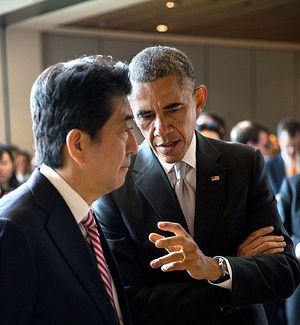On May 10, the White House announced that President Barack Obama will visit Hiroshima when he visits Japan to attend his final G7 Summit in Ise-Shima. Japanese Prime Minister Shinzo Abe will accompany Obama on his visit to Hiroshima.
Since Secretary of State John Kerry visited the Peace Memorial Park and Museum during his visit to Hiroshima for the G7 foreign ministerial meeting in April, the prospect for Obama’s visit to Hiroshima has been receiving renewed attention.
The question of whether a sitting U.S. president should visit Hiroshima is extremely politically sensitive. On the one hand, Obama’s visit would demonstrate his enduing personal commitment to the goal of a nuclear weapon-free world, which he proudly advocated in his speech in Prague in April 2009. On the other hand, a presidential visit could reopen the discussion within the United States regarding whether the use of atomic bomb—not only on Hiroshima but also on Nagasaki—was justified, given the massive civilian casualties. As Jennifer Lind articulates in her article in Foreign Affairs on April 8, 2016, a strong case can be made both why Obama should and why he should not visit Hiroshima as a sitting U.S. president.
But now that the decision has been made that Obama is going, what can and cannot (or should not) be expected from his visit?
First, Washington and Tokyo would likely emphasize that Obama’s visit to Hiroshima is as much about the future as it is about the past. The image of Obama and Abe visiting Hiroshima together will no doubt be a powerful message on the strong commitment by the two countries toward the goal of nuclear disarmament. It would also demonstrate the two leaders’ resolve on deterring nuclear proliferation at a time when North Korea, in the name of self-defense, continues to proceed with the development of its nuclear arsenal.
Despite intense speculation, Obama will steer clear of saying anything that can be interpreted as an apology during his visit to Hiroshima. Still, his visit will be received in Japan as an important gesture by a U.S. president that acknowledges the horror and devastation that the use of atomic bombs had caused — an act of respectful remembrance.
In the context of U.S.-Japan relations, therefore, Obama’s visit to Hiroshima is definitely positive.
The challenge for Tokyo and Washington is how to place Obama’s visit in the context of the global agenda that the leaders will discuss at the Ise-Shima G7 Summit. Kerry’s visit to Peace Memorial Museum and Park took place after the foreign ministers’ meeting and it still diverted attention away from what the foreign ministers discussed and agreed to in the meeting. Obama’s visit to Hiroshima, particularly because he visits Hiroshima before he attends the Ise-Shima G7 Summit, run even the greater risk that Obama’s visit to Hiroshima is all that will be discussed regarding the Summit itself.
Obama’s Hiroshima visit is no doubt historic. But the Ise-Shima G7 Summit that immediately follows is even more important, as the agenda is filled with global security and economic challenges that the leaders will have to tackle. As the host for the G7 summit that immediately follows, it will also be a test for Abe to ensure that the discussion in Ise-Shima will receive the attention it deserves without being completely overshadowed by Obama’s Hiroshima visit.

































